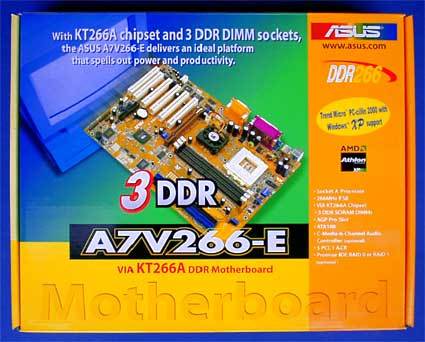Mega Test: 14 Boards with KT266A and nForce 420D
Asus A7V266-E - No Surprises Here
The Asus A7V266-E.
Board revision: 1.07
BIOS version: 1005b003
The Asus is delivered to the end customer in this packaging.
The new Asus board comes packaged in brighter colors that set it off much better from the competition than their old boards. For all its pretty packaging, though, the Asus A7V266-E didn't exactly bowl over the testers - the board is hardly different from the previous boards furnished with the KT133A and KT266 chipsets. Functionality is also pretty much old hat. A hold-over from the previous model, the A7V266 with the VIA KT266 chipset is the jumper block, which allows you to switch between an Athlon XP/MP with a Palomino core and a classic Athlon with a Thunderbird core. The real beauty of this feature lies in the activation of the overload protection, so that the signal sent by the thermal diode on the Athlon XP/MP can be evaluated. Seemingly as a matter of tradition, Asus includes an AGP Pro slot and a less useful ACR connector. At this point, every user will be asking himself or herself where in the dickens components for the ACR slot can be acquired.
Jumper to switch between newer Palomino and older Thunderbird cores.
The test board came furnished with a BIOS that provided for an FSB clock speed of 134.4 MHz. Setting BIOS to a standardized 133 MHz FSB speed was out of the question. We owe it to our good contacts at Asus that we received a BIOS with an almost specified clock speed in nearly no time. All the benchmark measurements have the A7V266-E in the upper third of the ratings. In fact, it even pummels all of the competition at compiling a Linux kernel, and in Sysmark 2000.
Get Tom's Hardware's best news and in-depth reviews, straight to your inbox.
Current page: Asus A7V266-E - No Surprises Here
Prev Page 12 Boards With VIA KT266A - Fastest Chipset For AMD & Duron Next Page Azza 366A-AV - Plain Jane

